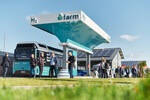Clean Hydrogen Scale Up is Feasible and Can Greatly Reduce Greenhouse Gas (GHG) Emissions
A new report on hydrogen decarbonization pathways published today by the Hydrogen Council shows that low-carbon hydrogen supply at scale is economically and environmentally feasible and will have significant societal benefits if the right localised approach and best-practices for production are used. The report also demonstrates that there is not one single hydrogen production pathway to achieve low lifecycle greenhouse gas (GHG) emissions, but rather the need for a fact-based approach that leverages regional resources and includes a combination of different production pathways. This will achieve both emission and cost reductions, ultimately helping to decarbonize the energy system and limit global warming.
In 2020, more than 15 countries launched major hydrogen plans and policies, and industry players announced new projects of more than 35GW until 2030. As this hydrogen momentum accelerates, it is increasingly clear that decision makers must put the focus on decarbonization to ensure hydrogen can fulfil its potential as a key solution in the global clean energy transition, making a significant contribution to net zero emissions. To support this effort, the two-part Hydrogen Council report provides new data based on an assessment of the GHG emissions generated through different hydrogen supply pathways and the lifecycle GHG emissions for different hydrogen applications (see report part 1 – A Life-cycle Assessment). In addition, the report explores 3 hypothetical hydrogen supply scenarios to measure the feasibility and impact of deploying renewable and low-carbon hydrogen at scale (report part 2 – Potential Supply Scenarios).
The report outlines that there are many ways of producing hydrogen and although GHG emissions vary widely, very high CO2 savings can be achieved across a broad range of different hydrogen production pathways and end-uses. For example, while “green” hydrogen produced through water electrolysis with renewable power achieves the lowest emissions, “blue” hydrogen produced from natural gas with high CO2 capture rate and storage can also achieve low emissions if best technologies are used and best practices are followed. Across eight illustrative pathways explored in the report, analysis shows that if hydrogen is used, significant GHG emission reductions can be made: as much as 60-90% or more, compared to conventional fossil alternatives. The study also looked into the gross water demand of hydrogen supply pathways. Water electrolysis has a very low specific water demand of 9 kg per kg of hydrogen compared to cooling of thermal power plants (hundreds of kg/kg) or biomass cultivation (hundreds to thousands of kg/kg).
Furthermore, low-carbon hydrogen supply at scale is fully achievable. Havinginvestigated two hypothetical boundary scenarios (a “green-only” and a “blue-only” scenario) to assess the feasibility and impact of decarbonized hydrogen supply, the report found that both scenarios are feasible: they are not limited by the world’s renewables potential or carbon sequestration (CCS) capacities, and they do not exceed the speed at which industry can scale. In the Hydrogen Council’s “Scaling up” study, a demand of 21,800 TWh hydrogen has been identified for the year 2050. To achieve this, a compound annual growth rate of 30-35% would be needed for electrolysers and CCS. This deployment rate is in line with the growth of the offshore wind and solar PV industry over the last decade.
Hydrogen Council data released in January 2020 showed that a wide range of hydrogen applications can become competitive by 2030, driven also by falling costs of renewable and low-carbon hydrogen[1]. The new study indicates that a combination of “green” and “blue” production pathways would lead to hydrogen cost reductions relative to either boundary scenario.By making use of the near-term cost advantage of “blue” while also scaling up “green” hydrogen as the most cost-efficient option in many regions in the medium and long-term, the combined approach lowers average hydrogen costs between now and 2050 relative to either boundary scenario.
“If hydrogen represents a global solution to decarbonize industry and to contribute to the energy transition, it’s only by reducing emissions along the chain and taking into account each local specificity that we will be able to unlock its full potential,” said Benoît Potier, Chairman and CEO of Air Liquide and Co-chair of the Hydrogen Council. “It will require a combination of several renewable and low-carbon pathways, facilitated by favorable regulations, as well as further industrial developments for low-carbon hydrogen technologies. While developing a low-carbon hydrogen production infrastructure is ambitious, it is already set in motion and a prerequisite for growing hydrogen’s role in the clean energy system.”
“Hydrogen is a key part of the energy transition and can achieve very high CO2 savings with the right approach. It is important to make hydrogen economically viable, but also to maximise its decarbonization impact and minimise its resource requirements. All signs point to hydrogen becoming a cost-competitive, decarbonized solution for a large number of applications before 2030 – all we need now is bold action to ensure hydrogen can live up to its full potential.” Takeshi Uchiyamada, Chairman of the Board of Toyota Motor Corporation and Co-chair of the Hydrogen Council added.
“The Hydrogen Council is committed to bringing fact-based research to the ongoing debate around the global energy transition and the clean technology solutions that will help us reduce emissions and reach our decarbonization objectives. With the unprecedented momentum of hydrogen right now, is it crucial that decision makers are equipped with the data that will help them plan for a step-change in hydrogen deployment globally,” said Daryl Wilson, Executive Director of the Hydrogen Council.
- Source:
- Hydrogen Council
- Author:
- Press Office
- Link:
- hydrogencouncil.com/...
- Keywords:
- Hydrogen Council, association, hydrogen, green, cost reduction, low carbon, GHC, emissions, renewable, fossil, energy source, athwa, policy, plan, country, report

























